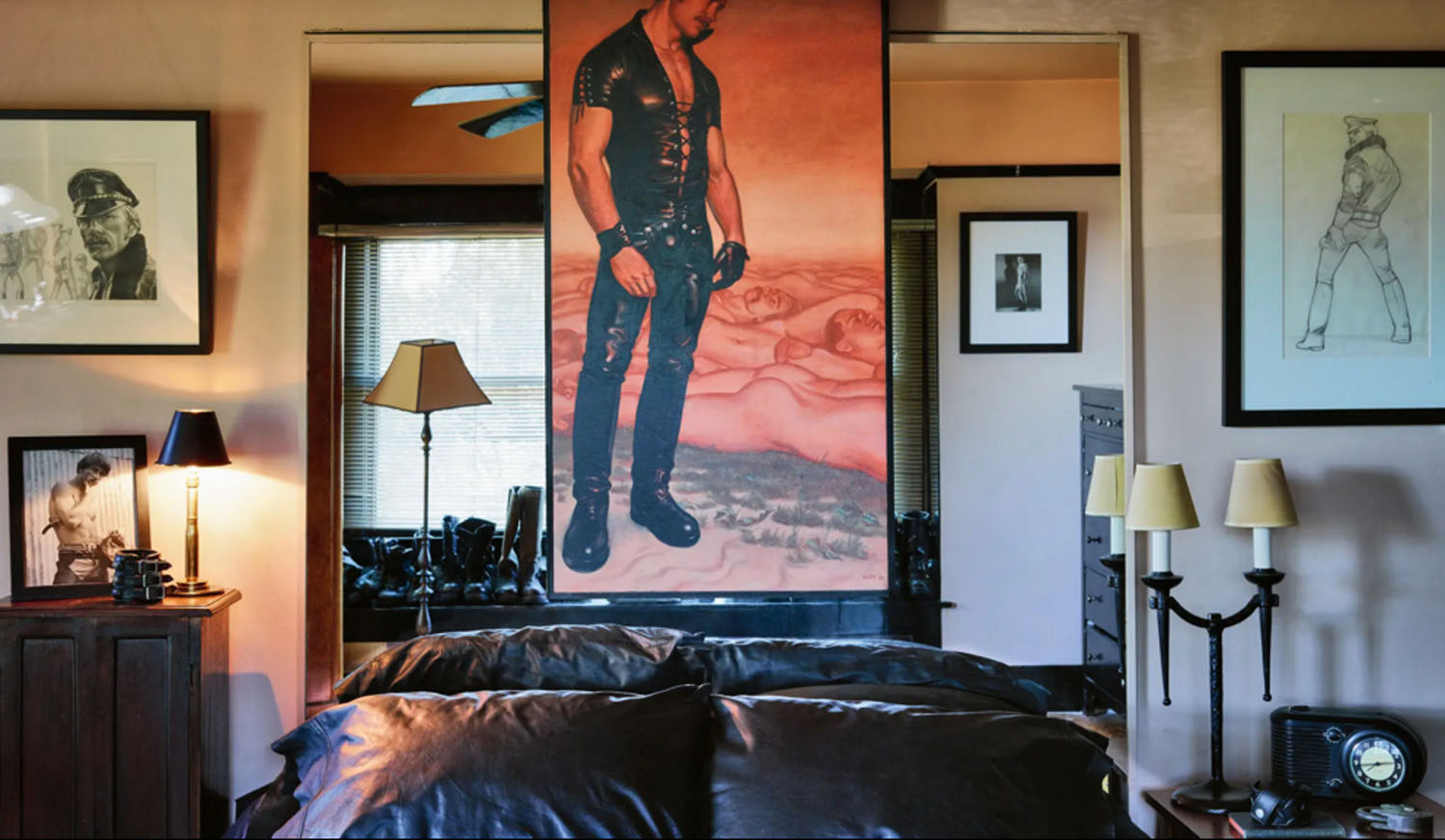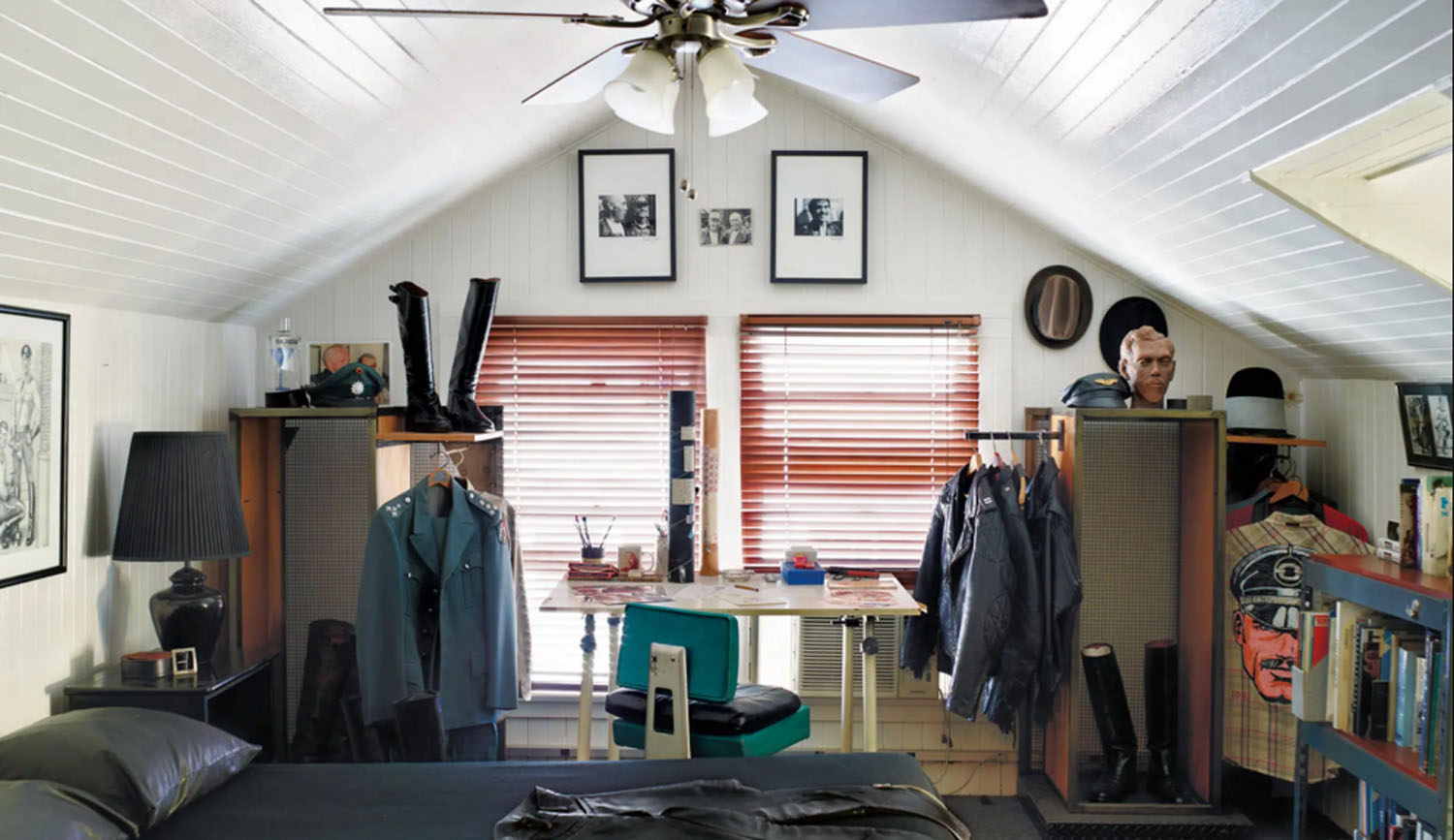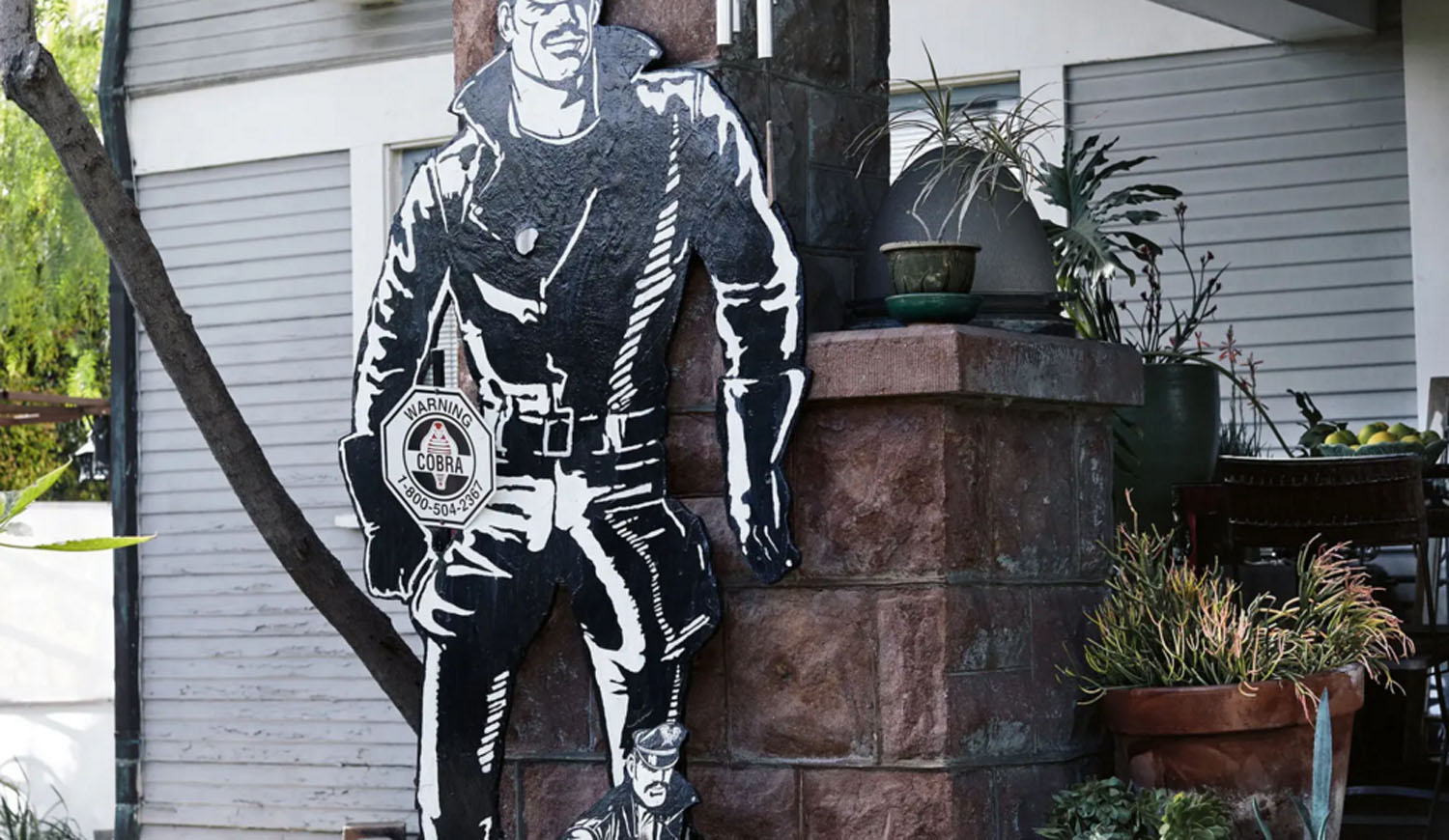TOM OF FINLAND FOUNDATION
Interview Michael Bullock
Portrait by Robert Pruzan, 1985
Interiors by Martyn Thompson
Sex Magazine 6, 2014
In 1980, Durk Dehner invited the trailblazing homoerotic artist Tom of Finland to live with him in Los Angeles. From then until his death in 1991 Tom split his time between the Echo Park residence and Finland, with Dehner wearing many hats: muse, model, lover, business partner, friend and cofounder of Tom of Finland Foundation, an organization dedicated to maintaining and building TOM’s archive, and as it states on its letterhead, “Protecting, Preserving and Promoting Erotic Art.” Last week, Tom of Finland Foundation celebrated its 29th birthday, a particularly joyful occasion as it happened in tandem with a landmark exhibition at MOCA LA, a clear summation of the Foundation’s years of hard work and affirmation of Tom of Finland’s proper place in history: a master artist, visionary and champion of sexual freedom whose body of work is important to society at large.
How did the Tom of Finland Foundation start?
My initial motivation for starting the Foundation was as a friend. I took Tom on because he needed to have a business associate that could move things forward. I knew that he wasn’t prepared to do that part of it and I just wanted to help him, especially in America. He wasn’t from here and he was so taken advantage of here.
How did people take advantage of him?
People were always illegally reproducing his work. You could find it all over the place, poorly printed. Oftentimes it never stated who published it, but it was distributed across the country.
Who was actually printing it?
It was the mafia. There was a printer in the San Fernando Valley that was reprinting his work. It’s funny, when we tried to get our first book published we ended up in their office. The printer shook Tom’s hand and immediately said, “I wanna thank you. I’ve made so much money off your work that I was able to put my son through college.” You could see Tom’s face get bright red and he was shaking his head up and down, trying to be agreeable, but it was a complete slap in the face.
Did you still print with them?
We had to because at the time we couldn’t find anyone that would print his work in Los Angeles. I mean here, in this metropolitan city they were so uptight about it. That continued for a long time. It was the same with galleries. They would rarely show explicit erotic work and if it was homosexual in nature, it was even more difficult. Museums certainly weren’t buying or collecting it so we had to find our own way.
How did you do that?
We created our own galleries and our own Art Fair Weekends that were designed to bring artists and potential collectors together. Through that, we developed our own collector base. I’m not saying the Foundation did this by itself, I’m saying it was the culture, the community. It was underground for many years and then it gradually surfaced.
Why did the Foundation care so much about helping other artists?
Tom felt that sexuality expressed in the visual arts is natural; it was one of the premises of his life and, when we don’t allow it, we censor what we could do and inhibit ourselves. He was unwilling to compromise what was creatively coming through him and because of that he sacrificed a faster road to…
Financial success?
Not necessarily. As I said we built a collector base. It was an interesting process because, through the Fairs, our community gave value to its own artists and their work. By raising the prices on ourselves we allowed the artist to be more secure so they could create more work.
Do you still have the Fairs?
We’re organizing a Fair in 2014 and we’re also having an Emerging Artist Competition. The guidelines are very simple in that the only rule is that you can’t have ever sold any of your work that is erotic in nature. We give support so that the artist will continue to nurture themselves. This is the twelfth Competition and the eighteenth Fair we have done. We’ve had a high success rate in those Competitions, with many artists such as Patrick Lee, Hector Silva and Jay Jorgensen going on to have healthy careers.
Was Tom often asked to tone it down by publishers?
Yes. All the time, publications would say “we’d love to print your work but we can’t show raw sexuality”. I mean we were just censored. We were invited by a respected gallery to be part of a museum exhibition in Lille, France. We picked the works and they came back to us two weeks later and said that the museum said no.

They uninvited you?
They said that because of the political climate there, gay marriage had just been approved and there was a lot of adverse reaction, so they were afraid to show Tom’s work and only showed one “soft” work. But the point is that it hasn’t gone away. Artist censorship is very much alive.
That’s why it’s amazing to finally see Tom’s show at MOCA. Can you explain how Tom and Bob Mizer figured their way around censorship as early as the late ‘50s?
Bob was the owner of the photo studio AMG (Athletic Model Guild), which put out a small periodical named Physique Pictorial that included photographs of male physiques and drawings by artists. At the time, it was one of the only ways that homosexual culture was getting fed and nurtured.
When did Tom draw his first cover for AMG?
\In the spring of 1957. Then he became the house artist for that periodical all the way through 1970. The publication was extremely subversive. Bob’s photos always used costuming, like cowboys and Indians, gladiators or Greek gods. It wasn’t just because it was gay fantasy. At the beginning in the ‘50s and ‘60s they had to do it because in order to publish images of half naked men they had to be considered “historically valuable.” That’s why they were always depicting a previous time in history.
I never could have imagined those themes were invented to protect them. I just thought it was camp.
Even as late as the ‘80s it was still tricky. That’s when Tom and I set up a mail order company together in order to sell catalogues of his drawings and merchandise. At that point, there were thirteen states in America that had really aggressive postal authorities that were trying to file federal lawsuits against mail order companies, especially gay. Once, Tom wanted to include a drawing called Police Orgy that included a fisting scene but we had to cover that act because fisting was classified as obscene: fisting, piss, scat, bestiality, and pedophilia, those were the five that would land you in prison.
Piss would land you in prison?
Yup. So anyway, we have an award to honor people who have made an important contribution to our community and one of them was Larry Flynt and he was gracious enough to come speak at the Awards Dinner we had for about a hundred artists. He told them “Stand your ground, stay strong. And never compromise.” That brings us back to Tom. Those were his principles and the same principles this Foundation was founded to support.
When did you first meet Tom?
I was twenty-six when I first discovered Tom’s work and I know what it did for me. He laid into his drawings, a message, an essence; he gave gay men an identity that they could be proud of. His drawings assured us that we were whole and complete. At the time, gay life was in the shadows, behind closed doors. Tom literally brought it into the light. A lot of the time, he showed his men making out in sunshine, out in the forest because he wanted to communicate that Mother Nature loved us, and that we didn’t have to buy into all of this demeaning crap that society had been dishing out.
Did he think of his work as activism?
He did, but you know he was Finnish. The thing about Finns is that they had been a suppressed people; they were dominated by the Russians and the Swedes and as a result they used to be very modest. But when he got older he finally said it. There’s a video where he’s speaking to some students at Cal Arts and he finally says it: that from the beginning he saw the plight of the homosexual as so pathetically horrible that he wanted them to know that they were perfect just the way they were. He wanted straight people to back off and let them have a chance. And he wanted to tell them that they deserved to be happy and to love in the way that they wanted to love. So he intended this, and this is what happened.
Was he able to see that he had achieved that before he died?
In the ‘80s he finally got it, that he had succeeded and succeeded at something pretty phenomenal. He was able to communicate that gay men weren’t alone. I was part of it and gay men all over were part of it. We all nurtured each other and it all was collective but Tom’s vision absolutely led the way. Harvey S. Shipley Miller, the trustee of the Judith Rothschild Foundation, called Tom of Finland one of the five most influential artists of the last century because his vision transcended art and became the culture. In the ‘80s, Tom of Finland was everywhere, in bars of every kind; it was in posters for events and in the music scene, in England. His imagery was with front men, like Adam Ant, Judas Priest’s Rob Halford, to Queen’s Freddie Mercury.
Not to mention gym culture.
Absolutely. If you follow and go back to where this whole national – international gym culture came from, you follow it back to California to the ‘50s and early ‘60s. In Los Angeles, there were three gyms. There was Gold’s in Santa Monica; there was Vince’s in North Hollywood and Jack LaLanne’s on Wilshire. Physique Pictorial inspired gay men to realize they didn’t have to be that effeminate cliché of the time, that they could actually look masculine and muscular like the men Tom and Bob presented. By the ‘70s there weren’t enough gyms in LA to keep up with the demand and it just kept going from there.
There was also that infamous Vivienne Westwood t-shirt.
Yeah, it appealed to everybody. It became sort of like, ‘who doesn’t like Tom of Finland’? In his world, cops weren’t trying to break up sex; they were encouraging it. The cops were sexual icons too. And everyone had a good time. There was humor. His heroes were always slightly embarrassed because they were caught in compromising situations. That’s a very Finnish thing; their heroes are humanized so the audience can relate.
Does the Foundation get criticized for being overly focused on sex?
The reason why the Foundation was established, beyond managing Tom’s archives, was to encourage and nurture work that is sexual in nature. Discrimination against sexual art is so dominant that it becomes a part of an artist’s psyche. It’s not that you have to always draw explicit sex but you should not have to even consider that you can’t include it. We still watch movies where they’re showing a woman front and back, but let me tell you they’re not showing a guy front and back. They’ll show his butt, but they won’t show his cock. What’s that about? Let’s just make it equal and get over this crap.
Well, what does the Foundation do to fight society’s ingrained self-censorship?
We forget that we’re a ritualistic people. As soon as we get socialized we want to hide it. That’s why on the equinox of every spring, the Foundation has its biggest party called The Rites of Spring. We have as many cocks around as we can. We have a cock altar, it’s lots of fun. It’s about celebrating; that’s what Tom did. He celebrated the cock.
How far back does the archive actually go?
We only have a few things from the beginning, from the 1950s, from before Tom got published, and it’s really a problem. That’s something I want to hammer into artists’ heads — is to capture everything that you do and keep an archive from the beginning. Do it as well as you can, because you have no idea how your art will be used twenty-five years from now.
One of the best things about the Foundation is the supporting materials, not just the drawings themselves.
Yes. Recently, we realized that we needed to pay better attention to Tom’s photographs. It was students from CalArts that slapped us across the face and made us realize they were also important. Tom photographed his models, developed his own film and made his own prints. Then he would cut his prints up and put them into reference binders, which were a mixture of his photographs, other guys’ photographs, and cutouts from magazines and everything. We realized that we needed to start showing them. So now we’re producing exhibition prints of Tom’s that are remarkable and he stands as a photographer.
I loved the collages at the MOCA show. They were all of faces and it showed how focused he was on getting the right attitude through his men’s facial expressions, the full range, joy, pleasure, mischief, bravado and as you said embarrassment.
Those collages that he used for reference are also being noted. He also did doodles, little silly doodles. He would take magazine cutouts, and would play with them – accentuate the right features to turn them into Tom of Finland men. All of this is now finally being looked at. He’ll always be known for his pencil work, his graphics but those materials are also important.
When did you first realize his preliminary sketches were of value?
In 1984 he brought 1,500 rough sketches from Finland to store at the Foundation. He never thought they were worthwhile outside of his archives. But I went “oh my god, these are amazing”. So immediately, I sent copies of them to our gallery in New York.
Which was Feature gallery?
Yes, Hudson is an amazing man, and did so much for Tom. Hudson exhibited Tom along with artists that he inspired like G. B. Jones. She’s a female artist that recreated Tom of Finland’s scenarios with lesbians. He also exhibited Martin of Holland, who made drawings of scat play. All of his men were covered in shit because shit is part of the gay tribal culture. It may not be manifested very much now but it was big then. He exhibited all of them in his gallery in SoHo and he never put up an explanation or a sign. This fucking sign shit. Trying to prevent someone from being offended. Fuck off, you know?
Did Tom ever get discouraged?
So much. I don’t think there’s any artist that has been ripped off as many times as him; it continued after he was dead. We still have to defend his copyrights. You have to fight for it and not let other people take what is yours. Tom got burned a lot. I saw him give up several times. It lasted about 48 hours, and he had to start drawing again. When someone is passionate, they get pissed off and they never give up. Not every artist is like that. But he was.
Any closing thoughts?
Well…Tom is not owned by gays, he’s owned by the world. I mean, his proprietary roots are with us, but we’re absolutely willing to share him for everyone to benefit. In 2006 we had an exhibition in Paris at Galerie Richard of a hundred works. It was cold, December, and this elegant woman, artist Rachel Laurent, walked in wearing a red overcoat. She just stood in the middle of the gallery and panned the room, looking at the art with this radiant smile. I went up to her and asked her what she was thinking. She said “I am standing at the bastion of freedom. Here lies the works of a man who never compromised what was in his heart. He represents freedom for all of us.” And I think that’s the way it is.




